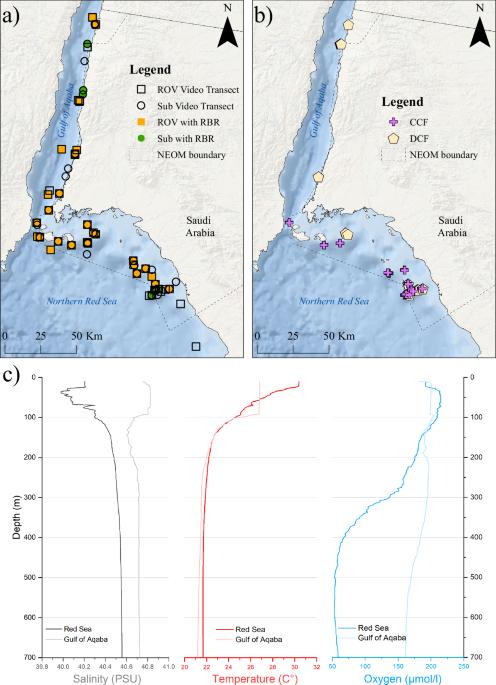Habitat suitability models reveal extensive distribution of deep warm-water coral frameworks in the Red Sea
IF 8.1
1区 地球科学
Q1 ENVIRONMENTAL SCIENCES
引用次数: 0
Abstract
Deep-sea coral frameworks are understudied in the Red Sea, where conditions in the deep are conspicuously warm and saline compared to other basins. Habitat suitability models can be used to predict the distribution pattern of species or assemblages where direct observation is difficult. Here we show how coral frameworks, built by species within the families Caryophylliidae and Dendrophylliidae, are distributed between water depths of 150 m and 700 m in the northern Red Sea and Gulf of Aqaba. To extrapolate the known (ground-truthed) positions of these deep frameworks, we use environmental and geomorphometric variables to inform well-performing maximum entropy models. Over 250 km2 of seafloor in our study area are identified as suitable for such frameworks, equivalent to at least 35% of the area of photic-zone coral reefs in the same region. We hence contend that deep-water coral frameworks are an important and underappreciated repository of Red Sea biodiversity. Deep-water coral frameworks may be an important and understudied source of biodiversity in the Red Sea, according to habitat suitability modelling generated using video imagery and in-situ coral sampling.

栖息地适宜性模型揭示了红海深层暖水珊瑚框架的广泛分布
红海的深海珊瑚框架研究不足,与其他海盆相比,红海的深海条件明显偏暖偏盐。栖息地适宜性模型可用于预测难以直接观察的物种或组合的分布模式。在这里,我们展示了红海北部和亚喀巴湾 150 米至 700 米水深范围内,由 Caryophylliidae 科和 Dendrophylliidae 科物种构建的珊瑚框架是如何分布的。为了推断这些深海框架的已知(地面勘测)位置,我们利用环境和地貌变量为性能良好的最大熵模型提供信息。在我们的研究区域内,超过 250 平方公里的海底被确定为适合建立此类框架,这相当于同一区域内光照区珊瑚礁面积的至少 35%。因此,我们认为深水珊瑚礁框架是红海生物多样性的一个重要而又未被充分重视的宝库。根据利用视频图像和现场珊瑚取样生成的栖息地适宜性建模,深水珊瑚框架可能是红海生物多样性的一个重要来源,但未得到充分研究。
本文章由计算机程序翻译,如有差异,请以英文原文为准。
求助全文
约1分钟内获得全文
求助全文
来源期刊

Communications Earth & Environment
Earth and Planetary Sciences-General Earth and Planetary Sciences
CiteScore
8.60
自引率
2.50%
发文量
269
审稿时长
26 weeks
期刊介绍:
Communications Earth & Environment is an open access journal from Nature Portfolio publishing high-quality research, reviews and commentary in all areas of the Earth, environmental and planetary sciences. Research papers published by the journal represent significant advances that bring new insight to a specialized area in Earth science, planetary science or environmental science.
Communications Earth & Environment has a 2-year impact factor of 7.9 (2022 Journal Citation Reports®). Articles published in the journal in 2022 were downloaded 1,412,858 times. Median time from submission to the first editorial decision is 8 days.
 求助内容:
求助内容: 应助结果提醒方式:
应助结果提醒方式:


